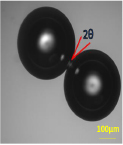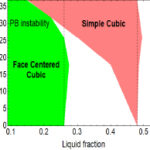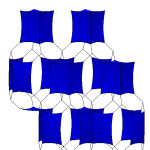Team
- Permanent member: Reinhard Hölher
Bubbles or monodisperse droplets suspended in water spontaneously self-organize into crystalline structures.
face-centered cubic or body-centered cubic, depending on the liquid fraction. The solidification of these structures by a reaction chemical process makes it possible to obtain light and very flexible materials. It has been shown that for the same constituents and the same volume fraction of air, one could obtain much stiffer materials for other ordered microstructures.
The simplest example is a simple cubic stacking, for which an increase in stiffness is expected along the axis of
symmetry 4. quadruple. However, for repulsive bubble interactions, these foams are unstable.
Our simulations show under which conditions the introduction of a controlled attractive interaction between bubbles (quantified by a contact angle) stabilizes simple cubic stacks, and gives rise to other new structures as shown below.
A controlled attraction can be induced by chemically modifying the foaming solution. The objective of our research
The current project is to obtain such foams experimentally, through a process of self-organization. The long-term perspective
of this work is to identify a pathway for the manufacture of new materials with high stiffness and low density.
 |
 |
 |
| Caption: Adhesive contact between two bubbles immersed in a TTAB/NaCl solution. . |
Caption: “Phase diagram” showing domains of stability of foam structures, depending on the bubble adhesion measured by a contact angle. | Caption: Example of an fcc foam transformed by an attractive interaction, inducing a Plateau border (« PB ») instability. |
Main collaborations
- Trinity College Dublin, Denis Weaire, (Stefan Hutzler)
- Institut Charles Sadron, CNRS, Strasbourg, (Wiebke Drenckhan)

